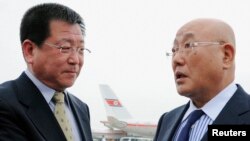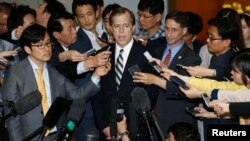SEOUL —
Japan's prime minister has sent an envoy to Pyongyang. The reason is not immediately clear, but Tokyo has, for years, been trying to resolve cases of Japanese abducted over past decades by North Korean agents.
A Japanese delegation led by an adviser to Prime Minister Shinzo Abe arrived in North Korea on Tuesday. Isao Iijima was met at Pyongyang airport by the vice director of the North Korean foreign ministry's Asian affairs department, Kim Choi Ho.
A decade ago, Iijima was a top aide to then-Japanese Prime Minister Junichiro Koizumi, who twice held talks in Pyongyang with North Korea's Kim Jong Il.
Over the past several months, diplomats have been shuttling among Washington, Beijing, Seoul and Tokyo urgently discussing North Korean issues.
When asked by VOA about the Japanese envoy's arrival in Pyongyang, Glynn Davies, the top U.S. diplomat responsible for North Korean matters said he was unaware of the visit.
“I had not heard that," Davies said. "So that will obviously be something that I will discuss with the Japanese when I have a chance to talk with my counterparts there in a couple of days.”
Davies was also asked about indications that North Korea has taken medium-range missiles off of launch stand-by status.
“It's of course, on the face of it, a good thing that North Korea did not fire missiles but that in and of itself doesn't get us very far toward the goal that we all seek, which is that North Korea gets back on the path of denuclearization,” he said.
Nuclear program
North Korea in recent months has made it clear it has no intention of abandoning its development of nuclear weapons and ballistic missiles.
It has also declared void the 1953 armistice halting the Korean War and threatened nuclear attacks against the United States.
Officials and analysts have noted a lull in the highly belligerent rhetoric from Pyongyang.
Han Min-koo, the former chairman of the South Korean Joint Chiefs of Staff, asserts, however, the North's provocations are certain to continue.
Speaking at the Asia Society Korea, the retired four-star general said it needs to be remembered, that above all else, North Korea's tolerance to absorb retaliation is high because other than the regime's survival it does not have priorities requiring protection.
Han contends Pyongyang does not care that much about the security of its citizens. So, he predicts, there will be action by the North, be it in the form of “an all-out attack, a low-cost provocation or creating instability on the Korean peninsula.”
When that happens, the retired general predicts, South Korean and U.S. forces will make a “timely and active response.”
Kaesong
Meanwhile, South Korean President Park Geun-hye has instructed the Unification Ministry to seek negotiations with Pyongyang about removing materials and products from the stalled joint industrial complex at Kaesong.
Operations have been suspended there since early last month after North Korea withdrew all of its 53,000 workers.
They were employed in more than 100 South Korean-run factories, mainly involved in textile production. The South withdrew all of its managers and support personnel from the zone after it became apparent the workers would not be returning any time soon.
A Japanese delegation led by an adviser to Prime Minister Shinzo Abe arrived in North Korea on Tuesday. Isao Iijima was met at Pyongyang airport by the vice director of the North Korean foreign ministry's Asian affairs department, Kim Choi Ho.
A decade ago, Iijima was a top aide to then-Japanese Prime Minister Junichiro Koizumi, who twice held talks in Pyongyang with North Korea's Kim Jong Il.
Over the past several months, diplomats have been shuttling among Washington, Beijing, Seoul and Tokyo urgently discussing North Korean issues.
When asked by VOA about the Japanese envoy's arrival in Pyongyang, Glynn Davies, the top U.S. diplomat responsible for North Korean matters said he was unaware of the visit.
“I had not heard that," Davies said. "So that will obviously be something that I will discuss with the Japanese when I have a chance to talk with my counterparts there in a couple of days.”
Davies was also asked about indications that North Korea has taken medium-range missiles off of launch stand-by status.
“It's of course, on the face of it, a good thing that North Korea did not fire missiles but that in and of itself doesn't get us very far toward the goal that we all seek, which is that North Korea gets back on the path of denuclearization,” he said.
Nuclear program
North Korea in recent months has made it clear it has no intention of abandoning its development of nuclear weapons and ballistic missiles.
It has also declared void the 1953 armistice halting the Korean War and threatened nuclear attacks against the United States.
Officials and analysts have noted a lull in the highly belligerent rhetoric from Pyongyang.
Han Min-koo, the former chairman of the South Korean Joint Chiefs of Staff, asserts, however, the North's provocations are certain to continue.
Speaking at the Asia Society Korea, the retired four-star general said it needs to be remembered, that above all else, North Korea's tolerance to absorb retaliation is high because other than the regime's survival it does not have priorities requiring protection.
Han contends Pyongyang does not care that much about the security of its citizens. So, he predicts, there will be action by the North, be it in the form of “an all-out attack, a low-cost provocation or creating instability on the Korean peninsula.”
When that happens, the retired general predicts, South Korean and U.S. forces will make a “timely and active response.”
Kaesong
Kaesong Joint Industrial Complex
Kaesong Joint Industrial Complex
-Started producing goods in 2004
-Employs about 53,000 North Koreans
-120 South Korean businesses operate there
-Hailed as rare example of North/South cooperation
-Generates $2 billion in trade annually for North
-Located 10 kilometers north of border
Operations have been suspended there since early last month after North Korea withdrew all of its 53,000 workers.
They were employed in more than 100 South Korean-run factories, mainly involved in textile production. The South withdrew all of its managers and support personnel from the zone after it became apparent the workers would not be returning any time soon.











